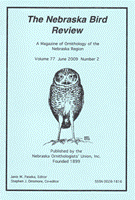Nebraska Ornithologists' Union

Nebraska Bird Review
Date of this Version
3-2016
Document Type
Article
Citation
Lefever, "Eight Years of Bird Banding in Nebraska’s Chadron State Park," from Nebraska Bird Review (March 2016) 84(1).
Abstract
Each autumn since 2008, the Bird Conservancy of the Rockies has sent a trained biologist to capture, band, and collect data on the birds that make use of the Pine Ridge region on their journey south. Eight years of mist-netting at Chadron State Park, in the heart of the Pine Ridge, has given insights into the unique assemblage of birds found there, and how alteration by fire can affect birds' use of the habitat. The Chadron State Park banding station is located on a hillside near the west edge of the park, with an overstory of Ponderosa Pines and a dense shrubby understory of smooth brome (grass) and chokecherry. Nebraska birders have long been aware of the diverse community of bird species that can be found on this island of pine trees sprouting up in the prairie, and the banding station has captured and banded 70 different species. Birds typical of the eastern half of the continent, such as Field Sparrow and Eastern Phoebe, have been documented over multiple seasons at the station along with iconic western species like Western Tanager and Townsend's Warbler. Over the years, the banding station has had the good fortune to catch a few regional rarities that would have likely gone undocumented otherwise. The 2013 season produced a Chestnut-sided Warbler and a Veery, both eastern migrants that are reported less than annually in western Nebraska. Another notable capture that season was a Dusky Flycatcher, the first ever banded in the state. The Pine Ridge (much of which is part of the Nebraska National Forest) is home to many summer breeders and year-round resident birds, too. Anyone visiting the state park can usually hear some of the resident Red Crossbills after a short time hiking around.
The banding station has collected data on many birds that were already banded. All recaptures at Chadron have been individuals that were previously banded at the site. While not typically thought to be as exciting as recaptures from other banding stations, this data provides important information on the molt cycle of post-breeding and hatch-year birds, migration preparation, and the stop-over efficiency of migrants. Spotted Towhees and House Wrens, the station's two most common migrant breeders, will often be captured multiple times early in the season.
The geographic location of Chadron State Park makes it suitable for subspecies to intermingle and even interbreed in the habitat surrounding the banding station. Northern Flickers are caught annually at the station, and 42% have displayed characteristics of both the yellow-shafted (eastern) and red-shafted (western) types. This zone of subspecies intergrades includes several other species which visit the banding station, such as Yellow-rumped Warblers. Over the years, the station has captured both Audubon's and myrtle subspecies of this warbler. Of the 54 total yellow-rumps captured since 2008, 54% were myrtles, while the other 46% were Audubon's. One diversely plumaged species captured annually at the station is the ubiquitous Dark-eyed Junco. Dark-eyed Juncos consist of 15 different subspecies which are grouped into 5 subspecies groups. Chadron lies within a small area of the continent where 4 of the 5 junco subspecies groups overlap, and all 4 have been captured at the station.
The most noticeable change at the banding station since the 2012 fire has been the increase in the number of captures each season. Prior to the fire, the station averaged 255 birds per season, with a high of 398 and a low of 146. When the fire hit in 2012, the station had to be moved and experienced an understandable all-time low of 118 captures. Since the fire, new record highs for number of captures have been set each year. The increase in bird activity around the mist nets, accounting for the increase in captures, is likely thanks to a quickly growing understory of plant life. Dense regeneration can be attributed to the wildfire, which removed old vegetation and thinned the canopy. We are optimistic that with continued good management practices, the park may continue to provide excellent cover and forage for the droves of winged travelers that depend on the region every autumn.


Comments
Copyright 2016 Nebraska Ornithologists’ Union. Used by permission.